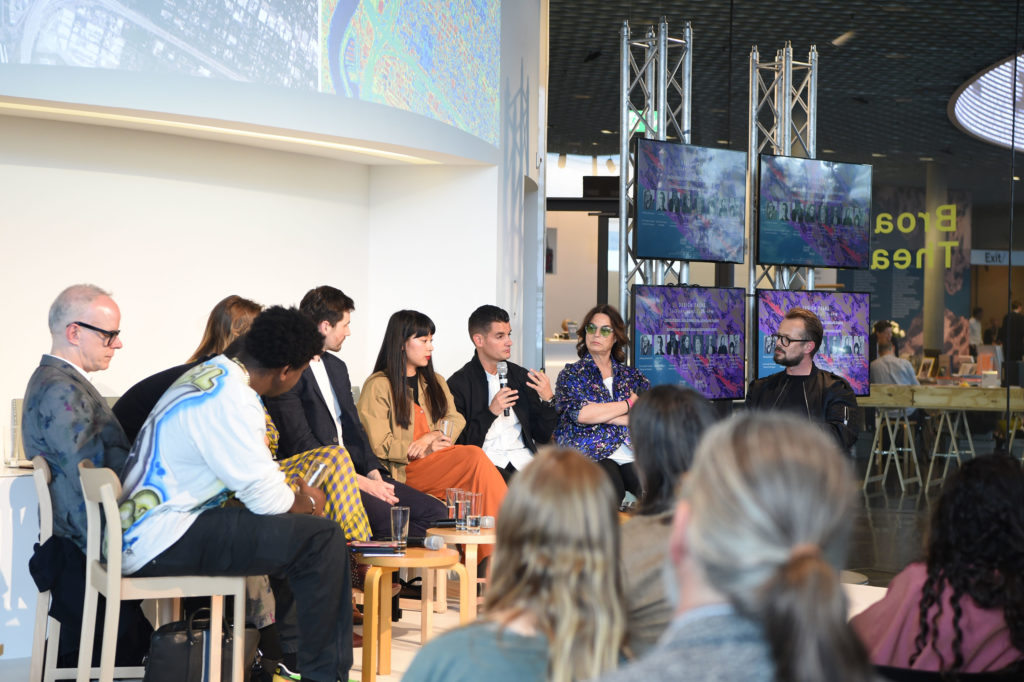
Architects and urban designers, in shaping the built environment, are increasingly tasked with addressing urgent social and political issues, including climate change, social equity, and aging infrastructure (and populations), alongside emerging questions of who informs urban design, and what sorts of perspectives and knowledge are fundamental to “good” urban design. Together with architects and engineers, might artists have a parallel role in steering our cities toward sustainable, inclusive futures?
Such interweaving of design perspectives lies at the heart of the Harvard Graduate School of Design’s Master in Design Studies program. In presenting at June’s Therme Forum, “The City of Artists–Cities Between Crisis, Catharsis and Creation,” MDes program codirector John May framed some of today’s urgent concerns around urbanization and globalization as questions of calibration, balance, and imbalance.
“We have to reimagine what it actually means to be local in such a way that it understands the value of global politics of cosmopolitanism, while recognizing the real material impacts of the history of globalization, in particular the 20th-century history of globalization and the environmental footprint that it has left on our cities,” May observed during the June 11 event in Basel. “This is, I think, a massive experimental political project going forward that’s just a huge open-ended question and we need more experiments like this to begin to answer those questions.”
This latest edition of Therme Forum was presented within Design Miami/Basel’s 2019 curatorial theme of Elements: Earth, responding to the impact of human activity on the nature of our planet. The public event gathered a series of noted theorists and practitioners toexamine how artists can share responsibility with urban planners, architects, and engineers in reenvisioning the cities of the future as they germinate today.
Among other considerations, the conversation raised the need to rethink city planning to counteract the pervasive effects of globalization and increasing digital technologies with solutions that enhance interpersonal experiences and social connections. Weighing these issues, panelists considered whether city design, as well as existing city environments, could emerge as a platform from which artists may stimulate significant cultural transformation.
“So now you wanted to know is nature important in an artist’s project? Yes. Is sustainability important? Yes. It’s important for the whole planet to become sustainable,” observed panelist Maja Hoffmann, founder and president of Luma Arles. “Now, what is the artistic gesture… you were saying it’s not enough to observe, you want actually to be active. So that means that if you take a role in society you become an activist. As an artist you can be an activist.”
Hoffmann and May were joined by co-panelists Lonneke Gordijn (artist, Studio Drift); Jon Gray (cofounder, Ghetto Gastro);Arthur Mamou-Mani (architect);Studio Swine (art collective); and Hans Ulrich Obrist (artistic director, Serpentine Galleries), with moderator Mikolaj Sekutowicz(curator, Therme Art Program).
At the GSD, May’s MDes program ties together a variety of disciplinary interests with one central question: How do we prepare for challenges that no longer conform to the boundaries of disciplines? MDes students and faculty experiment with this idea through a series of pedagogical lenses. The program’s Art, Design, and the Public Domain track asks questions similar to those raised at May’s June panel; most fundamentally it examines how art can intervene in civic crises or debates. Elsewhere in the MDes program, students and faculty consider ecology, conservation, technology, and philosophy as they bear on the design of buildings, communities, cities, and environments.
And, like the June Therme panel, the MDes program explores how alternative or non-traditional methodologies might cultivate novel approaches to design for this century.
In addition to his MDes directorship, May is an assistant professor of architecture and a founding partner, with the GSD’s Zeina Koreitem, of MILLIØNS, a Los Angeles–based design practice. Their experimental work has been featured in solo and group exhibitions at Friedman Benda Gallery, the Storefront for Art and Architecture, The Architecture + Design Museum of Los Angeles, and Jai & Jai Gallery, among others.
Similarly situated at the intersection of philosophy, technology, and the politics of environmentalism, May’s writings aim at a continual articulation of the conditions surrounding the contemporary design fields. His most recent book, Signal. Image. Architecture (Columbia, 2019), contemplates the psychosocial effects of transmissible electronic images, and their consequences for architecture and urbanism.